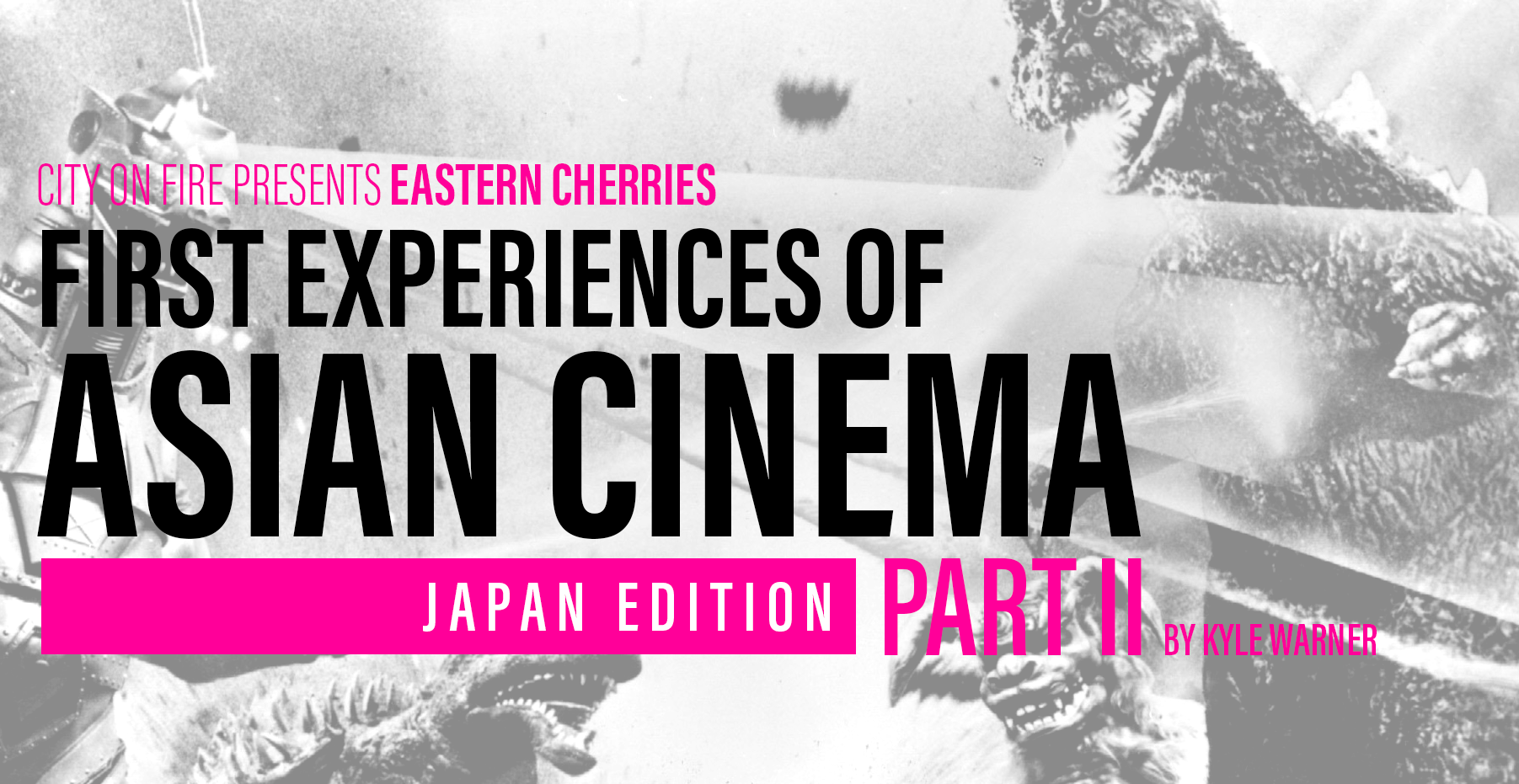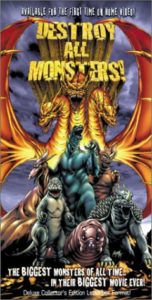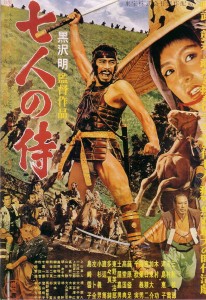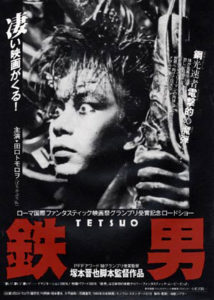 I think it’s fair to say that Japanese cinema was a part of my movie watching experience since childhood. I was a kid who loved dinosaurs and as a result I loved watching dinosaur and monster movies. I didn’t really understand until much later that a sizeable number of these movies were made in other countries, many of them in Japan. They were dubbed and, to be honest, the human characters were never what I was tuning in for. While Japanese movies and I go way back, I don’t think I really started to consider myself a fan of Japanese cinema until I got in deep with the classic Toho sci-fi movies.
I think it’s fair to say that Japanese cinema was a part of my movie watching experience since childhood. I was a kid who loved dinosaurs and as a result I loved watching dinosaur and monster movies. I didn’t really understand until much later that a sizeable number of these movies were made in other countries, many of them in Japan. They were dubbed and, to be honest, the human characters were never what I was tuning in for. While Japanese movies and I go way back, I don’t think I really started to consider myself a fan of Japanese cinema until I got in deep with the classic Toho sci-fi movies.
I’ve always loved Godzilla. Before the internet, I didn’t know when to expect a new Godzilla movie to be made available on US shelves, so I was always browsing the sci-fi section of Suncoast or Media Play for a new VHS release. The discovery of Destroy All Monsters on VHS at this one Media Play in Atlanta still ranks as one of the geekiest movie moments I have ever experienced. Cloud 9 happy.
But many of these VHS tapes sucked, if I’m being honest. I remember thinking for the longest time that the director of Godzilla vs. Mechagodzilla (titled Godzilla vs. the Cosmic Monster on my VHS box art) didn’t know how to shoot a movie because everything was so poorly lit. It wasn’t until I started buying the movies on DVD – including a large number of which I had never seen before – that I really started to appreciate the films for their craft. What’s more, the prints were so much better than what I’d seen on VHS. Jun Fukuda absolutely did know how to shoot a movie and the difference between the VHS Mechagodzilla and the DVD Mechagodzilla taught me an important lesson about film transfers and restoration work.
Though I was originally more of a fan of the 90’s Heisei era of Godzilla movies, the DVD wave of Godzilla films made me more of a fan of the Showa era that ran from the 50’s to the 70’s. It was around this time that I was introduced to Akira Kurosawa’s Seven Samurai. Seven Samurai knocked my socks off the way that few films had done before or since. It is an amazing achievement in filmmaking. To this day, I still consider it the best film I have ever seen. Toshiro Mifune is a wild man hero with electric screen charisma. Takashi Shimura is a beautiful contrast to Mifune, playing the stoic samurai who has seen too many battles. And the rest of the gang – from the badass warriors to the ever fearful farmers – is glowing with life. I was in love with Seven Samurai and I wanted more.
From there, I became a fan of Akira Kurosawa. I believe I started with the other Kurosawa/Mifune collaborations and then branched out from there. What an amazing duo those two made. Seven Samurai opened a door to some of the best films I had ever seen in my entire life. And I noticed something interesting, too: these movies often starred the same people from the classic science fiction films. There was a large talent overlap at Toho during the 50s and 60s. Many films were being produced at the same time and contracted actors basically walked from one set to the next as they made multiple films at once. Toho was a well-oiled movie making machine during those days. For me, a fan watching these films about forty to fifty years after they were produced, the crossover of talent only added to the charm of the movies. I got to know these actors that much faster because they were in everything.
In 1954, Takashi Shimura was the veteran lead actor in a cast full of young faces for the original Godzilla. He led the Seven Samurai that same year. He would then become one of those familiar character actors of Japanese cinema, splitting almost equal time between Kurosawa art pictures like Ikiru and Ishiro Honda’s sci-fi spectacles like Frankenstein Conquers the World. Akira Takarada’s first film role ever was the 1954 Godzilla. He then went on to be one of Godzilla’s regular leading men as well as working with the likes of Yasujiro Ozu and Mikio Naruse. Akihiko Hirata starred as the doomed Dr. Serizawa in 1954’s Godzilla, the same year he also starred in the first chapter of Hiroshi Inagaki’s Samurai Trilogy. Hirata would go onto become one of the most familiar faces in Toho’s science fiction and fantasy films. And then there’s the likes of Kumi Mizuno, Yoshio Tsuchiya, Akira Kubo, Kenji Sahara, Akiko Wakabayashi, Tatsuya Nakadai, Mie Hama, Hiroshi Koizumi, and of course, Mifune. This was not to say that it was an actor-driven filmmaking movement; exploring the classic Toho films introduced me to many amazing directors. But it was the familiarity of the stars that connected the movies and made it easier to dive in and explore.
Classic Japanese cinema then made me an admirer of Japanese cinema as a whole. Shinya Tsukamoto, Takeshi Kitano, Takashi Miike, Sion Sono, and Kiyoshi Kurosawa (no relation) are some of my favorite directors working today. Kaiju and samurai started my appreciation of Japanese cinema but I’m now also a fan of Japan’s crime pics, horror movies, and dramas about family life. The comedy is a bit hit and miss — some things get lost in translation — but I enjoy quite a few.
Lately, there are less and less Japanese productions making it over to DVD/Blu-ray shelves in America, and that’s too bad. Part of it is America’s apparent dwindling interest in foreign films, part of it is the shrinking sales of DVDs in general, but a lot of it is also Japanese cinema is having an odd moment right now. Politics and big corporations are more involved now and it’s not benefiting the art of movie making. That’s too bad. Hopefully things will improve, because there are obviously still plenty of talented filmmakers in Japan looking for the right opportunity.
Here at COF, we have so many good writers who can tell you all about Bruce Lee, Shaw Bros., and the Jackie Chan Stunt Team. I cannot. I enjoy the hell out of a good Hong Kong action movie but my appreciation rarely goes into how such a movie fits into HK film history. I am no expert, but Japanese movies are my thing. For whatever reason, samurai, giant monsters, and finger chopping clicked with me in a way that Bruce Lee never did (he’s still cool, though!).
Read Eastern Cherries – First Experiences of Asian Cinema: Japan Edition Part I
Read Eastern Cherries – First Experiences of Asian Cinema: Japan Edition Part III
Read Eastern Cherries – First Experiences of Asian Cinema: Japan Edition Part IV







Is now a good time to mention that I’ve never seen a Godzilla flick?
Burn the heretic! BURN HIM!!!! Lol
There’s plenty of required viewing I haven’t made time for myself.
*gasps* How can this be?! Haha. Well, if you’re ever interested, I’d say start with the 1954 original. I have a friend who has never seen a Bond or Indiana Jones movie before. I can understand missing Godzilla, but it was shocking to learn that this somebody had not seen a Bond or Indy movie. That’s like never seeing Star Wars and not knowing who Luke Skywalker is. Actually, I know somebody like that, too. So, yeah, movie blindspots happen.
Try to provide a link to the previous story in these types of series, thanks.
Done.
Thanks. 🙂
Hell yeah, Suncoast Video! I don’t think I actually bought that much there, just because their prices tended to be higher than what my allowance could afford at the time, but I always marveled at their selection. That was probably the first place I ever saw anime for sale in person.
They were very expensive. It was that “mall” overhead they had to cover.